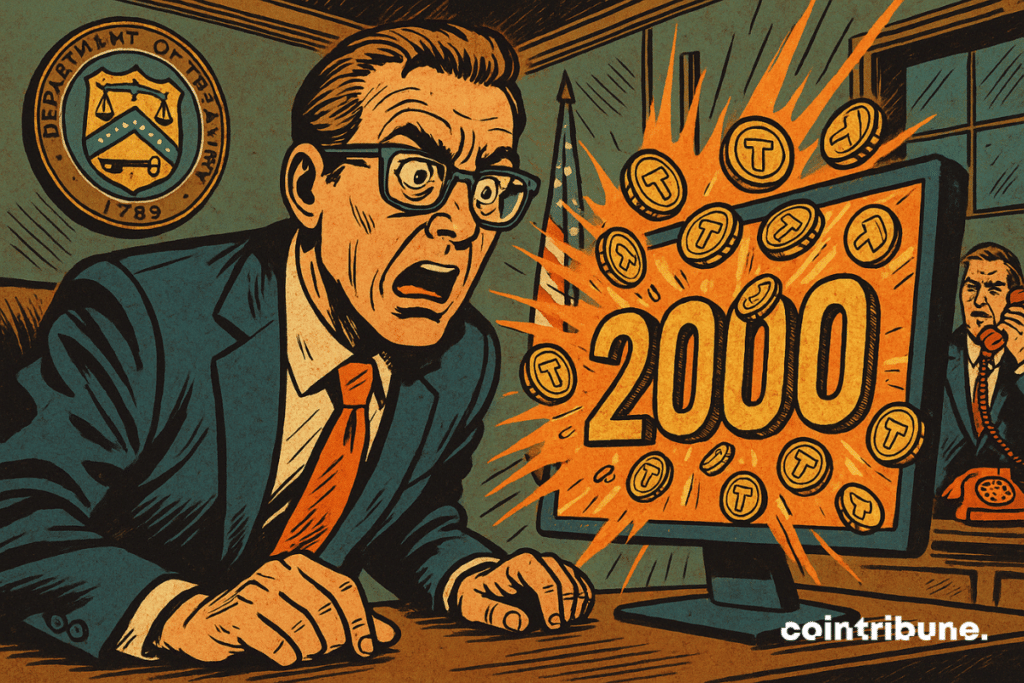Stablecoins: The U.S. Treasury Bets on a $2 Trillion Market
Secretary of the Treasury Scott Bessent has just made a striking prediction: the stablecoin market could explode to 2 trillion dollars within three years. This announcement comes as bitcoin flirts with its historic highs.

In Brief
- Scott Bessent predicts stablecoins will increase from 200 to 2,000 billion dollars in three years.
- The Senate votes favorably to regulate these US dollar-backed cryptos.
- Wall Street and major banks are preparing to invest heavily in this booming sector.
A Bold Prediction That Shakes Up the Crypto Industry
Scott Bessent made a notable statement before the House Ways and Means Committee. The U.S. Treasury Secretary believes that dollar-indexed stablecoins could see their market capitalization multiplied by ten.
This bold projection transforms a market currently valued at 200 billion dollars into a giant of 2,000 billion.
I believe that stablecoin legislation backed by U.S. treasuries or T-bills will create a market that will expand U.S. dollar usage via these stablecoins all around the world.
This strategic approach is clearly intended to counter threats to American monetary hegemony.
Standard Chartered Bank’s analysis supports this optimistic view. Geoff Kendrick, global head of digital assets research, points out that “ U.S. stablecoin legislation would further legitimize the sector“. This legitimization would have direct repercussions on Treasury bond purchases and dollar dominance.
Bessent’s strategy fits within a context of growing pressure on the dollar. U.S. debt threatens to exceed 40 trillion dollars in the next decade. Facing these challenges, stablecoins appear as a digital bulwark to preserve U.S. monetary influence.
Bitcoin and the Crypto Ecosystem Ride the Regulatory Wave
The bitcoin price has jumped 50% since its April low, dangerously approaching its historic record of 112,000 dollars. This exceptional performance is explained by growing optimism around U.S. crypto regulation.
The GENIUS Act, recently approved by the U.S. Senate, is the catalyst for this euphoria. This bill imposes 1:1 stablecoin reserves and offers much-awaited regulatory clarity.
Joel Kruger, strategist at LMax Group, describes this progress as a “significant tailwind” for the entire crypto market.
Wall Street giants are already anticipating this regulatory revolution. Brian Moynihan, CEO of Bank of America, confirmed that his bank will enter the stablecoin market as soon as the regulation is adopted.
“The problem before was that we were not clearly allowed to do so“, he explained during a Morgan Stanley conference.
This institutional legitimization profoundly transforms the perception of Bitcoin and cryptos. Mateusz Kara, CEO of Ari10, perfectly sums up this dynamic:
Even major banks are embracing cryptos. Like water and gravity, the rise of cryptocurrencies is inevitable.
The Trump administration is clearly orchestrating a long-term strategy. By turning stablecoins into pillars of digital finance, Washington intends to preserve the supremacy of the dollar amid geopolitical challenges.
This approach could generate colossal demand for U.S. Treasury bonds. Analysts talk about up to 1.6 trillion dollars in purchases over four years.
Scott Bessent’s vision goes beyond a simple economic forecast: it outlines an ambitious geopolitical strategy. By turning stablecoins into pillars of American finance, the United States could consolidate its monetary hegemony in the crypto era.
Maximize your Cointribune experience with our "Read to Earn" program! For every article you read, earn points and access exclusive rewards. Sign up now and start earning benefits.
Passionné par le Bitcoin, j'aime explorer les méandres de la blockchain et des cryptos et je partage mes découvertes avec la communauté. Mon rêve est de vivre dans un monde où la vie privée et la liberté financière sont garanties pour tous, et je crois fermement que Bitcoin est l'outil qui peut rendre cela possible.
The views, thoughts, and opinions expressed in this article belong solely to the author, and should not be taken as investment advice. Do your own research before taking any investment decisions.